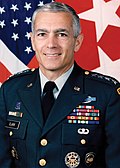| Supreme Allied Commander Europe | |
|---|---|
 SHAPE coat of arms | |
 Standard | |
| North Atlantic Treaty Organization Allied Command Operations (Supreme Headquarters Allied Powers Europe) | |
| Abbreviation | SACEUR |
| Reports to | North Atlantic Council, through NATO Military Committee |
| Residence | Chateau Gendebien |
| Seat | Casteau, Mons, Belgium |
| Nominator | President of the United States, with Senate advice and consent |
| Appointer | North Atlantic Council |
| Formation | 2 April 1951 |
| First holder | General of the Army Dwight D. Eisenhower |
| Website | shape.nato.int |
The Supreme Allied Commander Europe (SACEUR) is the commander of the North Atlantic Treaty Organization's (NATO) Allied Command Operations (ACO) and head of ACO's headquarters, Supreme Headquarters Allied Powers Europe (SHAPE). The commander is based at SHAPE in Casteau, Belgium. In effect, SACEUR is the second-highest military position within NATO, below only the Chair of the NATO Military Committee in terms of precedence. [2] There is another Supreme Allied Commander in NATO, Supreme Allied Commander Transformation (SACT), titularly equal, but whose duties are less operational. SACT, in Norfolk, Virginia, has responsibility for capability development rather than operations.
Contents
- List of holders
- Deputy
- Single DSACEUR (July 1993 – present)
- Role in intra-European defence integration
- DSACEUR's role in European Union missions
- See also
- References
- External links
SACEUR has always been held by a U.S. military officer, and the position is dual-hatted with that of Commander of United States European Command.
The current SACEUR is General Alexus G. Grynkewich of the US Air Force.







































